


xxxxxThe Irish
playwright and dandy Oscar Wilde gained literary fame in 1891 with
his The Picture of Dorian Gray - a
tale of social decadence with a strong Faustian theme - but
he is mostly remembered to day for the four social comedies by
which he shrewdly and wittily satirized the hypocrisies of
Victorian society. Among these were Lady
Windermere’s Fan and his most successful and most
enduring play The Importance of Being Earnest,
first staged in 1895.
He also wrote Salome in 1893, a verse
tragedy based on the biblical character, but this was banned in
Britain and was not staged, in Paris, until 1896. As a leading
member of the Aesthetic Movement - wherein art was for art’s
sake and was totally divorced, therefore, from moral or social
matters - he gained celebrity status for his flamboyant
dress, extreme affectation, and scandalous lifestyle, both at home
and during his tour of North America in the early 1880s. As a
journalist he wrote articles on a wide variety of subjects, and he
became known for his short stories. His career as a writer came to
an abrupt and sad end in 1885 when he sued for libel the Marquis
of Queensbury (the father of his current lover, Lord Arthur
Douglas) for accusing him of sodomy. He lost his case and this
opened him up to a charge of homosexuality. He was sent to prison
for two years with hard labour after being convicted of gross
indecency. On his release he wrote The Ballad
of Reading Gaol in 1898 - telling of the harsh
conditions of prison life - but his literary career was at an
end. He spent the last three years of his life in France, homeless
and almost penniless, and died in Paris of meningitis in November
1900. A witty, talented man, he numbered among his acquaintances
the art critic John Ruskin, the Irish playwright George Bernard
Shaw, and the American poets Henry Longfellow and Walt Whitman.
OSCAR WILDE 1854 -
1900 (Va, Vb, Vc)
(born Fingal O’Flahertie Wills
Wilde)
Acknowledgements
Wilde: detail, by
the American photographer Napoleon Sarony (1821-1896), 1882 –
Metropolitan Museum of Art, New York. Aesthetic Movement: by the American photographer Napoleon Sarony (1821-1896),
1882, - Metropolitan Museum of Art, New York. Wilde/Douglas: 1893, photographer unknown. Beardsely:
The Stomach Dance, an illustration for Wilde’s Salomé
– Victorian and Albert Museum, London. Moore:
by the French painter Édouard Manet (1832-1883), 1879 –
Metropolitan Museum of Art, New York. Gide:
by the French painter Paul Albert Laurens (1870-1934), 1924 –
Musée d’Orsay, Paris.
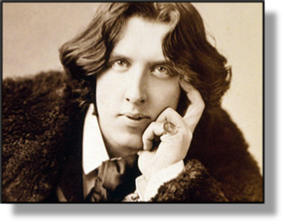 xxxxxThe Irish playwright and dandy Oscar Wilde was a
flamboyant character who dazzled London society by his
scintillating wit and outrageous behaviour during the last two
decades of the 19th century. He gained literary fame in 1891 with
his one and only novel The Picture of Dorian
Gray - a tale of moral decadence - but he is
best remembered today for his play The
Importance of Being Earnest of 1895, one of four social
comedies, all noted for their humorous dialogue and their
satirical attack upon the shortcomings of Victorian society. A
leading supporter of the Aesthetic Movement -
wherein art in all its forms was totally divorced from matters of
morality or social purpose - he gained celebrity status by
his public show of affectation and scandalous lifestyle. But the
last five years of his life proved hard and cruel in the extreme.
In 1895, at the height of his success, he was found guilty of
homosexuality. After serving two years of hard labour in prison,
he spent his remaining years in France, homeless and destitute.
xxxxxThe Irish playwright and dandy Oscar Wilde was a
flamboyant character who dazzled London society by his
scintillating wit and outrageous behaviour during the last two
decades of the 19th century. He gained literary fame in 1891 with
his one and only novel The Picture of Dorian
Gray - a tale of moral decadence - but he is
best remembered today for his play The
Importance of Being Earnest of 1895, one of four social
comedies, all noted for their humorous dialogue and their
satirical attack upon the shortcomings of Victorian society. A
leading supporter of the Aesthetic Movement -
wherein art in all its forms was totally divorced from matters of
morality or social purpose - he gained celebrity status by
his public show of affectation and scandalous lifestyle. But the
last five years of his life proved hard and cruel in the extreme.
In 1895, at the height of his success, he was found guilty of
homosexuality. After serving two years of hard labour in prison,
he spent his remaining years in France, homeless and destitute.
xxxxxWilde was
born in Dublin. Both his parents were successful writers, and from
an early age he benefited from the informed literary discussions
at his mother’s salon. After attending Portora Royal School at
Enniskillen, he gained a place at Trinity College, Dublin, in
1871, and excelled as a classical scholar and poet. After winning
the Berkeley Gold Medal for Greek, he went up to Magdalen College,
Oxford, in 1874, and four years later was awarded the prestigious
Newdigate Prize for his long poem about the ancient Italian city
of Ravenna. And it was while at Oxford
that he became an ardent supporter of the Aesthetic movement, with
its pithy slogan “art for art’s sake”. To emphasise his being a
man of superior culture and intelligence, he took to growing his
hair long, wearing velvet knee breeches, and striking languid
poses - as required for deep contemplation. He also filled
his rooms with objects of beauty, such as sunflowers, lilies and
peacock feathers, and cultivated a special admiration for his
“blue china”. Then and in his later years, such blatant
eccentricity attracted a great deal of ridicule -
understandably so - but no one could deny the brilliance of
his wit, his extraordinary flair, and the depth of his intellect,
and these gifts won him many devotees.
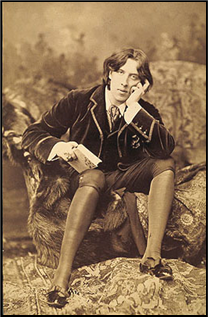 xxxxxAfter leaving Oxford he settled in London, and in
1881, after receiving moderate success with his first collection
of poems - much in the style of Rossetti, Keats and Swinburne
- he embarked on a highly successful lecture tour of the
United States and Canada, sponsored by Richard D’Oyly Carte, the
theatrical agent for Gilbert and Sullivan. Speaking at 140 venues
in the space of twelve months, and dressed to be noticed -
velvet jacket, knee breeches and black silk stockings! - he
extolled the virtues of the Aesthetic movement. Much of the press
was openly hostile towards him, but the general public was
intrigued by him, and he was well received in literary circles. On
his return he turned his talents to journalism. He toured Britain
and Ireland to give his “personal impressions” of North America,
and wrote articles on a variety of subjects, including art,
literature, fashion, and politics - many while editor of the
Woman’s World from1887 to1889. At the same time he produced a
series of provocative essays, notably The
Truth of Masks, The
Critic as Artist, The Decay of Lying,
and The Soul of Man Under Socialism, a
long political work in which he condemned capitalism and called
for the construction of a society where poverty “will be
impossible”.
xxxxxAfter leaving Oxford he settled in London, and in
1881, after receiving moderate success with his first collection
of poems - much in the style of Rossetti, Keats and Swinburne
- he embarked on a highly successful lecture tour of the
United States and Canada, sponsored by Richard D’Oyly Carte, the
theatrical agent for Gilbert and Sullivan. Speaking at 140 venues
in the space of twelve months, and dressed to be noticed -
velvet jacket, knee breeches and black silk stockings! - he
extolled the virtues of the Aesthetic movement. Much of the press
was openly hostile towards him, but the general public was
intrigued by him, and he was well received in literary circles. On
his return he turned his talents to journalism. He toured Britain
and Ireland to give his “personal impressions” of North America,
and wrote articles on a variety of subjects, including art,
literature, fashion, and politics - many while editor of the
Woman’s World from1887 to1889. At the same time he produced a
series of provocative essays, notably The
Truth of Masks, The
Critic as Artist, The Decay of Lying,
and The Soul of Man Under Socialism, a
long political work in which he condemned capitalism and called
for the construction of a society where poverty “will be
impossible”.
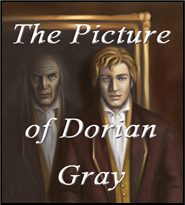
xxxxxIt was
during this period that Wilde began his career as a fiction
writer. He produced two collections of fairy tales - The
Happy Prince in 1888 and A House of
Pomegranates in 1892 - and he published a number of
semi-comic mysteries under the title Lord
Arthur Savile’s Crime and Other Stories. These were quite
well received, but recognition as a gifted writer - albeit a
controversial one - came in 1891 with the publication of his
one and only novel The Picture of Dorian Gray,
a chilling horror story with a strong Faustian theme. By means of
a pact with the devil (in the guise of his friend Lord Henry)
Dorian Gray retains his youth and good looks, leaving his portrait
to record not only the effects of ageing, but also the moral
decline engendered by his degenerate lifestyle.
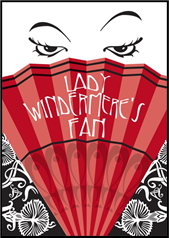
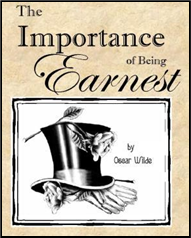 xxxxxBy this time, however, Wilde was keen to turn his
talent to the stage, and this was to prove his path to literary
fame. It was during the early 1890s that he produced the series of
engaging social comedies by which he has became best known.
Characterised by elaborate, farcical plots and sparkling with
remarkably witty dialogue and satirical epigrams, they craftily
exposed the hypocrisies of late-Victorian society. Lady
Windermere’s Fan was produced in 1892, followed in quick
succession by A Woman of No Importance,
An Ideal Husband, and The
Importance of Being Earnest. All where highly successful,
but the last named, first staged in 1895,
proved particularly popular and has remained so until this day.
Meanwhile, in 1893 Wilde produced his verse tragedy Salome,
written in French. Based on the biblical character and centred
around sexual passion, it was banned by the British censor and did
not receive its first performance, staged in Paris, until 1896.
xxxxxBy this time, however, Wilde was keen to turn his
talent to the stage, and this was to prove his path to literary
fame. It was during the early 1890s that he produced the series of
engaging social comedies by which he has became best known.
Characterised by elaborate, farcical plots and sparkling with
remarkably witty dialogue and satirical epigrams, they craftily
exposed the hypocrisies of late-Victorian society. Lady
Windermere’s Fan was produced in 1892, followed in quick
succession by A Woman of No Importance,
An Ideal Husband, and The
Importance of Being Earnest. All where highly successful,
but the last named, first staged in 1895,
proved particularly popular and has remained so until this day.
Meanwhile, in 1893 Wilde produced his verse tragedy Salome,
written in French. Based on the biblical character and centred
around sexual passion, it was banned by the British censor and did
not receive its first performance, staged in Paris, until 1896.
Vc-1881-1901-Vc-1881-1901-Vc-1881-1901-Vc-1881-1901-Vc-1881-1901-Vc-1881-1901-Vc
Including:
Aubrey Beardsley,
George Moore
and André Gide

xxxxxAn Irish
novelist and dramatist who knew Oscar Wilde as a child in Ireland
was George Moore
(1852-1933). He studied as an artist in Paris in the 1870s,
but, under the influence of the French realist novelist Émile
Zola, turned to writing in the 1880s. He gained recognition as a
novelist with his Esther Waters of 1894,
a convincing story of a young maidservant’s struggle against
poverty. In the early years of the 20th century he lived in
Ireland, contributing to the literary revival there with works
such as the play The Bending of the Bough and
the collection of short stories entitled The
Untilled Field. His later works, written in London, were
mainly historical in theme, and included The
Brook Kerith, a controversial story about the
Crucifixion. His autobiographical works, Confessions
of a Young Man and the trilogy Hail
and Farewell, by their frankness, attracted a great deal
of interest at the time. He also wrote two volumes of poems, and a
book in defence of French Impressionism.
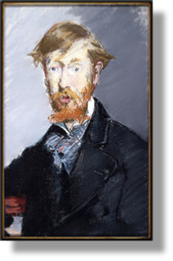 xxxxxAn Irish novelist, dramatist and poet who knew Oscar
Wilde in his early years was George
Moore (1852-1933). As children they
spent summer holidays at Moytura in County Mayo. Moore chose to
become an artist and, as from 1873, spent seven years in Paris.
There he came to know a number of Impressionist painters,
including Manet, Renoir, Monet, Pissarro and Degas, but he also
met and came under the influence of the realistic novelist Émile
Zola. While studying in Paris he wrote a volume of verse, Flowers
of Passion, and, on returning to London - following
a stay in Ireland - he turned to writing novels aimed at
challenging the conventional plots and characters of Victorian
literature. Three novels in the closing years of the century, Modern Lover, A Mummer’s
Wife and A Drama in Muslin
were realistic enough to be banned in some quarters for offending
good taste, but his reputation was established in 1894 with Esther Waters, a convincing story of a young
domestic servant with an illegitimate son who struggles to
overcome hardship and poverty. Evelyn Innes
followed in 1898 and Sister Theresa in
1901.
xxxxxAn Irish novelist, dramatist and poet who knew Oscar
Wilde in his early years was George
Moore (1852-1933). As children they
spent summer holidays at Moytura in County Mayo. Moore chose to
become an artist and, as from 1873, spent seven years in Paris.
There he came to know a number of Impressionist painters,
including Manet, Renoir, Monet, Pissarro and Degas, but he also
met and came under the influence of the realistic novelist Émile
Zola. While studying in Paris he wrote a volume of verse, Flowers
of Passion, and, on returning to London - following
a stay in Ireland - he turned to writing novels aimed at
challenging the conventional plots and characters of Victorian
literature. Three novels in the closing years of the century, Modern Lover, A Mummer’s
Wife and A Drama in Muslin
were realistic enough to be banned in some quarters for offending
good taste, but his reputation was established in 1894 with Esther Waters, a convincing story of a young
domestic servant with an illegitimate son who struggles to
overcome hardship and poverty. Evelyn Innes
followed in 1898 and Sister Theresa in
1901.
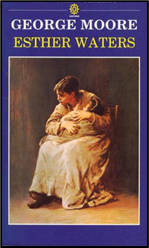

xxxxxHe lived in
Ireland from 1901 to 1910 where he contributed to the Irish
literary revival with such works as his play The
Bending of the Bough, his collection of short stores
entitled The Untilled Field, and his
psychological novel The Lake. After
1911 he lived mainly in London, but in 1913 he travelled to
Jerusalem to gather material for The Brook
Kerith, a novel about the Crucifixion. His later novels
were mainly historical and included Heloise
and Abelard in 1921 and his last work Aphrodite
in Aulis.
xxxxxHis
autobiographical works Confessions of a Young
Man - which included a frank account of his bohemian
life in Paris during the 1870s - and the trilogy Hail
and Farewell, attracted a great deal of interest at the
time. He also produced a second volume of poetry, Pagan
Poems, in 1881, and in 1893 wrote Modern
Painting, a defence of French Impressionism. (The
portrait of Moore is by the French Impressionist painter Édouard
Manet.)
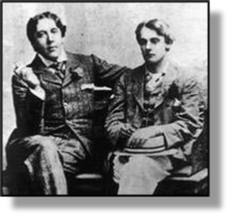 xxxxxInx1895 however, at the
height of his success, Wilde - then in a homosexual
relationship with Lord Alfred Douglas (nicknamed “Bosie) (1870-1945) - had his
career and life shattered. It was in that year that the Marquis of Queensbury (1844-1900),
Douglas’ father, having long abused and threatened Wilde over his
liaison with his son, openly accused him of sodomy. Urged on by
Bosie, Wilde brought a libel action against Queensbury but,
following one of the most sensational trials of the century -
during which Wilde’s private life was disclosed in much detail -
Queensbury’s accusation was found to be “true in substance and in
fact”. This left Wilde open to a charge of homosexuality, and he
was sentenced to two years hard labour in May 1895. This brought
an end to his promising career as a playwright, and led to his
social and financial ruin.
xxxxxInx1895 however, at the
height of his success, Wilde - then in a homosexual
relationship with Lord Alfred Douglas (nicknamed “Bosie) (1870-1945) - had his
career and life shattered. It was in that year that the Marquis of Queensbury (1844-1900),
Douglas’ father, having long abused and threatened Wilde over his
liaison with his son, openly accused him of sodomy. Urged on by
Bosie, Wilde brought a libel action against Queensbury but,
following one of the most sensational trials of the century -
during which Wilde’s private life was disclosed in much detail -
Queensbury’s accusation was found to be “true in substance and in
fact”. This left Wilde open to a charge of homosexuality, and he
was sentenced to two years hard labour in May 1895. This brought
an end to his promising career as a playwright, and led to his
social and financial ruin.
xxxxxFollowing
his downfall, Wilde only wrote two other works: De
Profundis (From the Depths),
an apology for his life - written as a letter to Bosie but
not published until 1905 -, and The
Ballad of Reading Gaol, a long poem about the harshness
of prison life, completed in 1898. On his release he spent the
remaining three years of his life in France, homeless and almost
penniless, but he was reunited with Douglas for a short while. He
died of meningitis in Paris in November 1900, and was buried in
the city’s Père Lachaise Cemetery.
xxxxxWilde’s
reputation - having outlived the prudery of the Victorian era
- rests mainly upon his brilliance as a social commentator of
that period. A brilliant conversationalist and a man of
scintillating wit, he numbered among his acquaintances the English
art critic John Ruskin (who, along with William Morris, strongly
opposed the aesthetic movement), the Irish playwright George
Bernard Shaw, and the American poets Henry Longfellow and Walt
Whitman, both of whom
he met during his lecture tour in the United States.
xxxxxIncidentally, a plaque on the esplanade at Worthing marks the
site of the house where he wrote The
Importance of Being Earnest. He was staying at this
English seaside town in the summer of 1894, and was inspired to
write the play after reading an article in the Worthing
Gazette about a baby who had been found in a hamper at
London’s King’s Cross Station. He wrote the play in three weeks
and named the hero Jack Worthing in honour of the town. ……
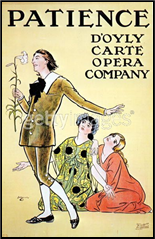
xxxxx……xxPatience,
the comic light opera by Gilbert and Sullivan (librettist and
composer), first performed in 1881, was a powerful satire on the
aesthetic movement. The main character, the aesthetic sham
Bunthorne, was mainly intended as a skit upon the English poets
Swinburne and Rossetti, but Wilde did not escape ridicule. At one
time, as the play records, he did “walk down Piccadilly with a
poppy or a lily in his medieval hand”! The comical periodical Punch also poked fun at him on a number of
occasions, andxthe satirical novel Green Carnation, published in 1894 by the
English writer Robert Smythe (1864-1950), was a satire on his mannerisms.
xxxxx……xxIn 1895, at the height of
his row with Wilde, the Marquis of Queensbury planned to throw a
bouquet of rotten vegetables onto the stage at the first
performance of The Importance of Being Earnest. Wilde got to hear about this
and had him banned from the theatre. Today Queensbury, an
enthusiastic patron of sport, is mostly remembered as the man who
gave his name to the modern rules governing boxing, introduced in
1867. …...
xxxxx……xxWilde greatly admired the
works of Keats.
He considered Byron to be a rebel and Shelley to be a dreamer, but
valued Keats for the calmness and clearness of his vision. ……
xxxxx……xxWilde was renowned for
his witty sayings. Here are but a few: The only way to get rid of
temptation is to yield to it. … There
is no such thing as an immoral book. Books are well written or
badly written. … I never travel without
my diary. One should always have something sensational to read in
the train. … One should never trust a
woman who tells her real age. Such a woman would tell one
anything. … Experience is the name
everyone gives to their mistakes.
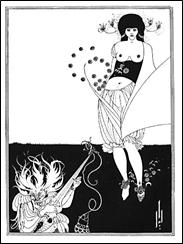 xxxxxThexoriginal version of Wilde’s verse tragedy Salome
was written in French in 1891 and published two years later.
Banned from being shown in Britain, the play was first staged in
Paris in 1896. The English translation was published in 1894 and
this version was illustrated by the English artist Aubrey
Beardsley (1872-1898), a leading
member of the aesthetic movement. His black and white drawings,
influenced by Japanese prints, were generally considered erotic
and decadent, and those drawn to illustrate Salome
brought him wealth and fame. His style, noted for its sinuous
lines and foliate motifs (seen earlier in the designs of the Pre-Raphaelites)
was characteristic of Art
Nouveau. This
international movement in the visual arts, interior design and
architecture, flourishing in the closing years of the 19th
century, aimed to make a complete break from the art of classical
times. Later, In 1905, Wilde’s Salome
was produced as a one-act opera by the German composer
Richard Strauss.
xxxxxThexoriginal version of Wilde’s verse tragedy Salome
was written in French in 1891 and published two years later.
Banned from being shown in Britain, the play was first staged in
Paris in 1896. The English translation was published in 1894 and
this version was illustrated by the English artist Aubrey
Beardsley (1872-1898), a leading
member of the aesthetic movement. His black and white drawings,
influenced by Japanese prints, were generally considered erotic
and decadent, and those drawn to illustrate Salome
brought him wealth and fame. His style, noted for its sinuous
lines and foliate motifs (seen earlier in the designs of the Pre-Raphaelites)
was characteristic of Art
Nouveau. This
international movement in the visual arts, interior design and
architecture, flourishing in the closing years of the 19th
century, aimed to make a complete break from the art of classical
times. Later, In 1905, Wilde’s Salome
was produced as a one-act opera by the German composer
Richard Strauss.
xxxxxAnother close
friend of Oscar Wilde was the homosexual French writer, literary
critic and social crusader André Gide (1869-1951). They first met in Paris and then in
Algiers in 1895. In general, Gide’s works were autobiographical,
concerned with the constant conflict within himself between the
puritan demanding conventional behaviour and the pagan wanting to
explore the desires of the flesh. In his case the puritan did not
always prevail! His first major work on this theme was The
Fruits of the Earth published
in 1897, and this was followed, in the new century, by a stream of
works, including The Immoralist, Strait is the Gate, The
Vatican Cellars, The Counterfeiters,
and Corydon, the last being a bold
defence of homosexuality. Also worthy of mention is his The
Pastoral Symphony, a psychological study of love and
responsibility. As a literary critic he wrote for the New
French Review, and his Journal,
a set of diaries, attracted much interest. He was awarded the
Nobel Prize for Literature in 1947.
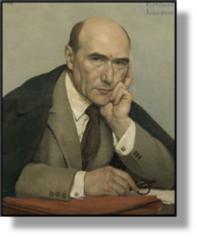 xxxxxAnother close friend of Oscar Wilde was the
homosexual French writer, literary critic and social crusader André Gide (1869-1951).
They first met in Paris and then in Algiers in 1895, where Wilde
was accompanied by Lord Alfred Douglas.
xxxxxAnother close friend of Oscar Wilde was the
homosexual French writer, literary critic and social crusader André Gide (1869-1951).
They first met in Paris and then in Algiers in 1895, where Wilde
was accompanied by Lord Alfred Douglas.
xxxxxMost of
Gide’s works were autobiographical, wherein a search for self-realization
was for ever troubled by the conflict between the puritan in him,
constrained by the demands of conventional behaviour, and the
pagan in him, anxious to explore the desires of the flesh. In his
case the puritan did not always prevail! His first major work on
this theme, The Fruits of the Earth,
made little impact when published in 1897, but later it became one
of his most influential books, encouraging as it did the
expression of individual freedom, regardless of the fabricated
norms of the society to which one belonged.
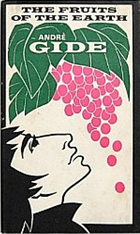 xxxxxHis other works, as from 1902, included The
Immoralist, Strait is the Gate,
The Counterfeiters, and The
Vatican Cellars, an anti-Catholic satire which
brought the inevitable condemnation. His Corydon,
published in part from 1911 and in full in 1924, was a bold, open
defence of homosexuality and was likewise attacked. By contrast, The Pastoral Symphony of 1919 was a moving
tale of love and responsibility, woven around a blind girl who
eventually gains her sight. It was a simple,
xxxxxHis other works, as from 1902, included The
Immoralist, Strait is the Gate,
The Counterfeiters, and The
Vatican Cellars, an anti-Catholic satire which
brought the inevitable condemnation. His Corydon,
published in part from 1911 and in full in 1924, was a bold, open
defence of homosexuality and was likewise attacked. By contrast, The Pastoral Symphony of 1919 was a moving
tale of love and responsibility, woven around a blind girl who
eventually gains her sight. It was a simple,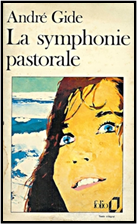 straight forward story on the surface, but it had a rare
psychological depth and proved a popular work.
straight forward story on the surface, but it had a rare
psychological depth and proved a popular work.
xxxxxGide’s
contribution as a literary critic was primarily made in the
prestigious periodical The New French Review, which he had helped to found in
1909, and his four volume Journal,
covering the years 1939 to 1951, attracted worldwide interest. In
addition, he also proved an able translator. He translated, among
other works, Shakespeare’s Antony and
Cleopatra, and works by the English poet William Blake
and the American poet Walt Whitman.
xxxxxIn the mid-1920s,
working as an envoy for the French colonial office, he visited the
county’s African colonies and was appalled at the exploitation of
the native people, conducted mainly by commercial companies who
had been awarded trading concessions. Two reports, published as Travels in the Congo in 1929, went some way
to improving the situation. And his sympathy for working people
showed itself in the early 1930s, when Gide came out in favour of
the communist “experiment” taking place in the Soviet Union. His
allegiance was short lived however. After visiting Russia in 1936
he made clear his disillusionment with the system in his Return
from the U.S.S.R. His novels and plays, together with
his critical works, had a profound influence on French literature
and writing further afield. He was
awarded the Nobel Prize for Literature in 1947.
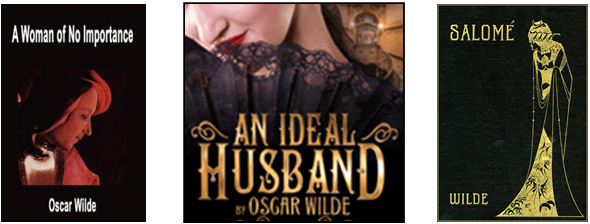






 xxxxxThe Irish playwright and dandy Oscar Wilde was a
flamboyant character who dazzled London society by his
scintillating wit and outrageous behaviour during the last two
decades of the 19th century. He gained literary fame in 1891 with
his one and only novel The Picture of Dorian
Gray -
xxxxxThe Irish playwright and dandy Oscar Wilde was a
flamboyant character who dazzled London society by his
scintillating wit and outrageous behaviour during the last two
decades of the 19th century. He gained literary fame in 1891 with
his one and only novel The Picture of Dorian
Gray - xxxxxAfter leaving Oxford he settled in London, and in
1881, after receiving moderate success with his first collection
of poems -
xxxxxAfter leaving Oxford he settled in London, and in
1881, after receiving moderate success with his first collection
of poems -

 xxxxxBy this time, however, Wilde was keen to turn his
talent to the stage, and this was to prove his path to literary
fame. It was during the early 1890s that he produced the series of
engaging social comedies by which he has became best known.
Characterised by elaborate, farcical plots and sparkling with
remarkably witty dialogue and satirical epigrams, they craftily
exposed the hypocrisies of late-
xxxxxBy this time, however, Wilde was keen to turn his
talent to the stage, and this was to prove his path to literary
fame. It was during the early 1890s that he produced the series of
engaging social comedies by which he has became best known.
Characterised by elaborate, farcical plots and sparkling with
remarkably witty dialogue and satirical epigrams, they craftily
exposed the hypocrisies of late-
 xxxxxAn Irish novelist, dramatist and poet who knew Oscar
Wilde in his early years was George
Moore (1852-
xxxxxAn Irish novelist, dramatist and poet who knew Oscar
Wilde in his early years was George
Moore (1852-

 xxxxxInx1895 however, at the
height of his success, Wilde -
xxxxxInx1895 however, at the
height of his success, Wilde -
 xxxxxThexoriginal version of Wilde’s verse tragedy Salome
was written in French in 1891 and published two years later.
Banned from being shown in Britain, the play was first staged in
Paris in 1896. The English translation was published in 1894 and
this version was illustrated by the English artist Aubrey
Beardsley (1872-
xxxxxThexoriginal version of Wilde’s verse tragedy Salome
was written in French in 1891 and published two years later.
Banned from being shown in Britain, the play was first staged in
Paris in 1896. The English translation was published in 1894 and
this version was illustrated by the English artist Aubrey
Beardsley (1872- xxxxxAnother close friend of Oscar Wilde was the
homosexual French writer, literary critic and social crusader André Gide (1869-
xxxxxAnother close friend of Oscar Wilde was the
homosexual French writer, literary critic and social crusader André Gide (1869- xxxxxHis other works, as from 1902, included The
Immoralist, Strait is the Gate,
The Counterfeiters, and The
Vatican Cellars, an anti-
xxxxxHis other works, as from 1902, included The
Immoralist, Strait is the Gate,
The Counterfeiters, and The
Vatican Cellars, an anti- straight forward story on the surface, but it had a rare
psychological depth and proved a popular work.
straight forward story on the surface, but it had a rare
psychological depth and proved a popular work.


